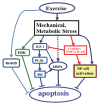Effects of aging and exercise training on apoptosis in the heart
- PMID: 24278863
- PMCID: PMC3836520
- DOI: 10.12965/jer.130002
Effects of aging and exercise training on apoptosis in the heart
Erratum in
- J Exerc Rehabil. 2013 Dec;9(6):549
Abstract
Aging is characterized by a progressive decline in cardiac function. A critical contributor to the age-related impairment in cardiac function is the loss of cardiac myocytes through "apoptosis", or programmed cell death. Structural remodeling in the heart with advancing age includes (a) loss of cardiomyocytes, (b) reactive hypertrophy of the remaining cardiomyocytes, and (c) increased connective tissue and altered geometry. The loss of cardiomyocytes with aging occurs through apoptosis. Particularly, mitochondrial-mediated apoptotic pathway is the best characterized and believed critical in regulating apoptosis with aging, suggesting that mitochondria are very important sites of programmed cell death. It has been also reported that mitochondrial dysfunction, oxidative stress, and impaired stress response contribute to age-induced mechanical remodeling as well as apoptosis. In contrast, exercise training not only improves cardiac function, but also reduces the risk of heart disease. We recently found that aging increased mitochondrial-mediated apoptotic signaling and apoptosis in the left ventricle, while chronic exercise training was effective in diminishing mitochondrial-mediated apoptotic signaling pathways in the aging heart, as indicated by lower DNA fragmentation, terminal deoxynucleotidyl transferase-mediated dUTP nick end labeling (TUNEL)-positive staining, and caspase-3 cleavage, when compared with left ventricles from the age-matched sedentary group. In this review, we will provide a comprehensive update regarding the effects of aging and exercise training on apoptosis in the heart.
Keywords: Aging; Apoptosis; Heart; Mitochondria; Myocytes.
Figures



References
-
- Anversa P, Palackal T, Sonnenblick EH, Olivetti G, Meggs LG, Capasso JM. Myocyte cell loss and myocyte cellular hyperplasia in the hypertrophied aging rat heart. Circ Res. 1990;67:871–885. - PubMed
-
- Beere PA, Russell SD, Morey MC, Kitzman DW, Higginbotham MB. Aerobic exercise training can reverse age-related peripheral circulatory changes in healthy older men. Circulation. 1999;100:1085–1094. - PubMed
-
- Booth FW, Chakravarthy MV, Gordon SE, Spangenburg EE. Waging war on physical inactivity: using modern molecular ammunition against an ancient enemy. J Appl Physiol. 2002;93:3–30. - PubMed
-
- Brocheriou V, Hagege AA, Oubenaissa A, Lambert M, Mallet VO, Duriez M, Wassef M, Kahn A, Menasche P, Gilgenkrantz H. Cardiac functional improvement by a human Bcl-2 transgene in a mouse model of ischemic/reperfusion injury. J Gene Med. 2000;2:326–333. - PubMed
Publication types
LinkOut - more resources
Full Text Sources
Other Literature Sources
Research Materials

